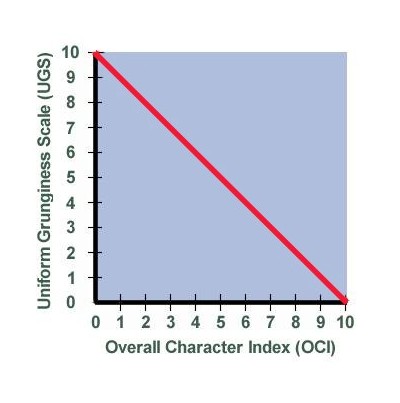Top Scientist Discovers Relationship Between Character and Grunge
Leaders of the anti-grunge movement have asserted for years that grunginess and character are inextricably tied together. Hard evidence has been lacking, though, and those attempting to defend the anti-grunge position have been forced to rely on empirical data and anecdotal folklore.
In recent years, many scholars have tried to solve this problem, but only recently have significant advances been made. Through all this, one top scientist, Dr. Charles Brown, has relentlessly pursued the truth; finally, he has made an astounding breakthrough that reveals once and for all the link between grunge and character-- or lack of character.
Dr. Brown wanted to create a graph showing this relationship but had no data with which to do so. This did not deter him; he merely set to work creating it. Two measures would be needed. One would be a measure of character. The other would be a measure of grunginess. This seemed fairly straightforward but in fact took many years of exacting research and experimentation.
First, Dr. Brown developed the grunginess measure. He calls it the "Uniform Grunginess Scale," or UGS for short. The UGS measures the suitability of all aspects of the subject's clothing from head to toe. Higher weight is given to clothes directly in the line of sight of others, such as sunglasses and shirts. Lower weight is given to clothes not seen as readily, such as shoes, although such articles of clothing are not entirely discounted by any means. Clothes not visible at all are not evaluated for the purposes of the UGS, although a subject not wearing any clothes is automatically assigned a UGS of 10, the highest rating and least favorable. The lowest rating, zero, is the most favorable.
Having developed the UGS, Dr. Brown realized that his next task was to measure character. To do this, he created the "Overall Character Index," or OCI. The OCI measures twenty-five key indicators of a person's integrity and character. These indicators are then entered into a complex formula that Dr. Brown co-developed with a graduate student at a local university. The computer program which calculates the OCI took three years to develop and perfect and is rumored to be as long as 100,000 lines of source code.
Next, with all the requisite measuring tools at hand, Dr. Brown set about calculating the UGS and OCI for a sample of 100,000 subjects selected randomly from the general population. Each subject was asked to complete a 50-page questionnaire and was then placed under observation for six months in order to accumulate the necessary information for calculating the UGS and OCI.
Finally, Dr. Brown and his staff sifted through the reams of data they had collected and began to develop the graph which would tell the whole unvarnished story of how grunginess affects character. Nine months later, the results were ready to be published in scientific journals around the world. Many of Dr. Brown's peers were skeptical, but none could refute the excruciatingly detailed report and its accompanying graph which now threatens to change the world.
The graph, now known as "Brown's Theory," is striking in its simplicity; in fact, the conclusion that Brown drew is so obvious that many have questioned the need to spend such long hours in preparing it. Brown refuses to comment on the graph, saying that it speaks for itself-- which may well be the most eloquent thing that anyone could possibly say about it.
Below, we reproduce the now-famous graph which describes "Brown's Theory." Judge for yourselves whether grunge and character are related. Remember, the more grunge found on a person, the higher the UGS will be; dress clothes lower the UGS. A person of good character, such as Abraham Lincoln, will have a high OCI, while a dishonest, lazy person will likely have a low OCI.


